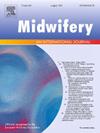Expanding the practice placement capacity in pre-registration midwifery education: A scoping review
IF 2.6
3区 医学
Q1 NURSING
引用次数: 0
Abstract
Background
Practice placements are an essential component of midwifery education, enabling students to apply their theoretical knowledge in a real-world midwifery setting. Exposure and immersion to practice is a core focus of midwifery education internationally. These placements are crucial for students to develop the skills and expertise needed to become safe, competent, and compassionate midwife practitioners. However, access to appropriate placements has become a significant challenge, compounded by increasing student numbers. This review aims to synthesise knowledge on practice placements used in midwifery education and identify strategies to increase placement capacity.
Methods
A scoping review framework was utilised to present a broad understanding and knowledge synthesis of the available literature to identify the types of practice placements currently used within pre-registration midwifery education and identify opportunities to increase capacity for the future. Arksey and O'Malley's five-step framework was utilised and this review is reported in line with the Preferred Reporting Items for Systematic Reviews and Meta-analysis for Scoping Reviews (PRISMA-ScR).
Findings
The review identified eleven papers from five different countries. These papers highlight different practice placements utilised to develop competencies and potentially increase practice placement capacity for midwifery students. Community-based placements helped students understand practitioners' roles, while continuity of care models facilitated skill development and positive practice outcomes. Innovative settings such as student-led clinics and rural placements improved students' competence and learning experiences and are seen as successful strategies to develop competency and increase capacity. However, challenges like work-life balance issues and unclear role delineation were observed in some placements, which had a negative impact on student experiences.
Conclusion
This review emphasises the importance of developing and establishing new practice placement locations to develop competencies and increase the practice placement capacity in pre-registration midwifery education, ultimately leading to more qualified midwives. To achieve this objective, it is essential to explore opportunities in various settings, including midwifery group practices in the community, caseload midwifery practice, birth centres, private midwifery practice, rural placements, student-led activities, and primary care settings such as community health clinics. These findings can guide educational institutions and policymakers in developing diverse, sustainable placement opportunities to meet the growing demand for skilled midwives.
扩大注册前助产教育的实习安置能力:范围审查。
背景:实习是助产教育的重要组成部分,使学生能够将他们的理论知识应用到现实世界的助产环境中。接触和沉浸在实践中是国际助产教育的核心重点。这些实习对培养学生成为安全、称职、富有同情心的助产士从业人员所需的技能和专业知识至关重要。然而,在学生人数不断增加的情况下,获得合适的实习机会已成为一项重大挑战。这篇综述的目的是综合知识的实践安置使用在助产教育和确定战略,以提高安置能力。方法:利用范围审查框架对现有文献进行广泛的理解和知识综合,以确定目前在预注册助产教育中使用的实践安置类型,并确定未来增加能力的机会。采用Arksey和O'Malley的五步框架,并按照系统评价和范围评价荟萃分析的首选报告项目(PRISMA-ScR)进行报告。研究结果:该综述确定了来自5个不同国家的11篇论文。这些论文强调了不同的实践安置,用于发展能力,并有可能增加助产士学生的实践安置能力。以社区为基础的实习帮助学生了解从业者的角色,而护理模式的连续性促进了技能发展和积极的实践成果。学生主导的诊所和农村实习等创新环境提高了学生的能力和学习经验,被视为发展能力和提高能力的成功战略。然而,在一些实习中,工作与生活的平衡问题和角色划分不清等挑战对学生的体验产生了负面影响。结论:本综述强调了在预注册助产教育中发展和建立新的实习地点以培养能力和提高实习能力的重要性,最终导致更多合格的助产士。为了实现这一目标,必须在各种环境中探索机会,包括社区助产小组实践、个案助产实践、生育中心、私人助产实践、农村实习、学生主导的活动以及社区卫生诊所等初级保健环境。这些发现可以指导教育机构和政策制定者开发多样化、可持续的安置机会,以满足对熟练助产士日益增长的需求。
本文章由计算机程序翻译,如有差异,请以英文原文为准。
求助全文
约1分钟内获得全文
求助全文
来源期刊

Midwifery
医学-护理
CiteScore
4.50
自引率
7.40%
发文量
221
审稿时长
13.4 weeks
期刊介绍:
Midwifery publishes the latest peer reviewed international research to inform the safety, quality, outcomes and experiences of pregnancy, birth and maternity care for childbearing women, their babies and families. The journal’s publications support midwives and maternity care providers to explore and develop their knowledge, skills and attitudes informed by best available evidence.
Midwifery provides an international, interdisciplinary forum for the publication, dissemination and discussion of advances in evidence, controversies and current research, and promotes continuing education through publication of systematic and other scholarly reviews and updates. Midwifery articles cover the cultural, clinical, psycho-social, sociological, epidemiological, education, managerial, workforce, organizational and technological areas of practice in preconception, maternal and infant care.
The journal welcomes the highest quality scholarly research that employs rigorous methodology. Midwifery is a leading international journal in midwifery and maternal health with a current impact factor of 1.861 (© Thomson Reuters Journal Citation Reports 2016) and employs a double-blind peer review process.
 求助内容:
求助内容: 应助结果提醒方式:
应助结果提醒方式:


